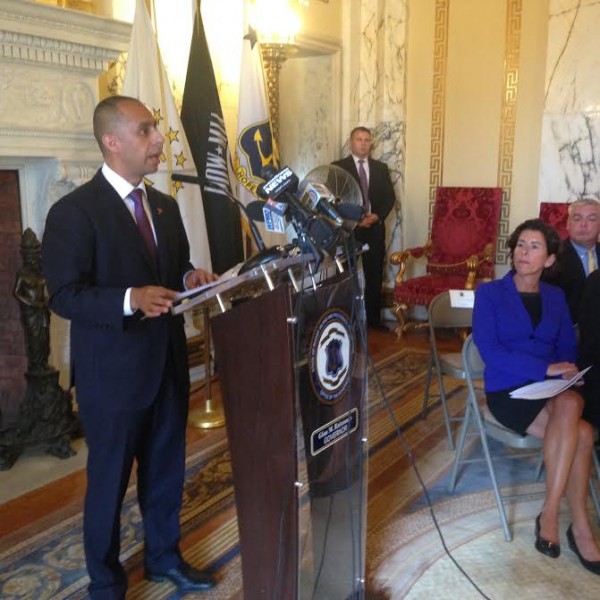 Please join me in giving a round of applause to Mayor Elorza and the Providence Department of Planning and Development for their hard work and due diligence every step of the way during the 6/10 Connector’s community engagement process.
Please join me in giving a round of applause to Mayor Elorza and the Providence Department of Planning and Development for their hard work and due diligence every step of the way during the 6/10 Connector’s community engagement process.
The city has been extremely transparent and open, taking the public’s input into consideration while drafting their design for the future of the 6/10 Connector. It is reassuring to know that the mayor and the planning department are actively listening to the needs and wants of the community. By taking a bottom-up approach, the City of Providence is conveying that its interests align with that of its communities, and appreciates the ideas and solutions that its residents bring to the table. Who else knows what’s best for the City of Providence other than the residents that live, work, and thrive here.
On Monday, October 3, the City released their draft plans for the future of the 6/10 Corridor at a public forum held at the Doorley Jr. Municipal Building in downtown Providence. While the City’s plans do not call for a surface boulevard that I and other community members would have liked to see presented, I can tolerate the parkway design. The parkway concept addresses the concerns of both sides about the looming question, “What should the future of the 6/10 Connector look like?” The plan addresses the need to fast-track the reconstruction of the structurally deficient Huntington Viaduct, out of concern that the structure might collapse. The plan appeases auto-interests as well as those citizens who want to see a concept that is more pedestrian and bike friendly, although we would much prefer a pure boulevard instead of a parkway.
The proposed parkway plan frees up land for development (approximately 50 acres), expands the footprint of DePasquale Square, adds two new off-street bike paths, creates a new exit to West Exchange Street, adds additional connections to the existing street grid, and reconnects parts of Olneyville to the urban fabric of Providence, among other things as well. The proposed “halo” elevated rotary where Route 6 merges with Route 10 allows for the potential to incorporate boulevard elements into sections of the route further down the line. While the entire length of the 6/10 Connector isn’t the pure boulevard that many of us had envisioned, the two-phased parkway plan allows the City and State to revisit the compelling arguments made in favor of an intermodal boulevard.
The most important aspect of the plan isn’t the plan itself. Rather, it is culmination of everything that has led to the plan being drafted in the first place. It is the countless hours spent by engaged citizens, who took it upon themselves to get involved, speak out, and voice their opinions about the project; citizens who persevered even when things weren’t going their way because they knew that this is a critical, once-in-a-lifetime opportunity to turn the 6/10 Connector into something truly special. Without vocal citizens and lots of vigorous discussions, RIDOT would probably have elected to refurbish the highway a long time ago, and that wouldn’t have worked for motorists, bicyclists, pedestrians, and city residents alike.
The future of the 6/10 Connector will single-handedly change the physical, social, and economic makeup of the city for generations to come. It is up to us as citizens to decide whether or not we want to make Providence a more livable community for our children, our children’s children, and ourselves. Or, if we want to sit idle, content with the current economic conditions in our Capital City. The choice is ours. RIDOT has the final say about the project’s design, and I strongly encourage my fellow Rhode Islanders to continue to be actively involved in the process, and vocal about the future we envision for a livable, thriving city for decades to come.
]]>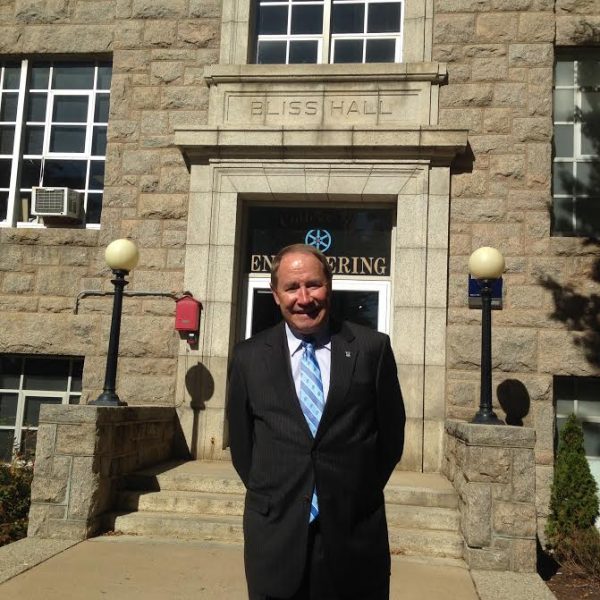 There are two University of Rhode Island projects that would benefit if voters pass Question 4 on the statewide ballot this November.
There are two University of Rhode Island projects that would benefit if voters pass Question 4 on the statewide ballot this November.
One is a $25.5 million upgrade to Bliss Hall, a prominent classroom building on the Quadrangle at the center of campus that was built in 1929, and “hasn’t really been renovated since then,” said URI President David Dooley in a recent interview with RI Future.
“The exterior will look exactly the same except the air conditioners won’t be sticking out the window any more because we will have state-of-the-art HVAC,” Dooley explained, “and there will be an addition on the back facing all the new engineering construction that will be going on behind Bliss Hall starting next year.”
The Bliss Hall renovation is part of an overall $150 million project, started under Governor Chafee, to upgrade the engineering program and its facilities, which Dooley described as a major area of growth at URI.
“We know it is one of our fastest growing colleges,” he said, noting there are more than 30 local businesses started by graduates of URI’s engineering school. “We know that every year we have more applications to the College of Engineering than we did the year before. We know we can’t accommodate all the qualified applicants that want to come here to become engineers.”
The second part of Question 4 would direct $20 million to fund “innovation campuses” – or partnerships with the private sector.
“We want to do things that broadly build a robust and successful economy in this state and in the nation,” Dooley told me. “I do think we know enough about the importance of innovation and growing the American economy and keeping America competitive in an increasingly competitive global economy and we know enough about how innovation can fuel not just economic prosperity but also enhance the social fabric of the state and the nation to know that these kind of centers – which are well-precedented, and there are a wealth of success stories out there – can work, can be a magnate for investment in Rhode Island and can attract new talent into Rhode Island as well as create a wealth of new opportunities for the Rhode Islanders that are already here.”
Companies would apply in a public process, that has yet to be defined, and provide matching funds. The $20 million could go to several companies, or just one. “We know that they are going be selected on the basis of what looks like a good return on Rhode Island’s investment in terms of new jobs, new businesses and economic growth,” Dooley said. “How those get translated into very specific points is yet yet to be determined. We certainly expect to play a role in that because we think we have a lot of expertise to share in those areas.”
URI already has such partnerships with companies such as Amgen, Hasbro, Ratheon and Schneider Electric.
“We’ve already got some examples of companies that have come to Rhode Island specifically because they wanted to work closely with URI,” Dooley said, mentioning Navatek in Wakefield. “They are a Hawaii-based company. They opened up their second office right here in proximity to URI just so they could work with URI faculty and students on ocean engineering.”
Dooley said he was comfortable, both professionally and personally, if a defense contractor started an innovation campus with URI.
“To a degree, I can be comfortable with that because I do think we have a responsibility as the world’s leading democracy to provide leadership and in our 21st Century world that continues to mean that in addition to all the robust diplomatic efforts you can mount, you have to have the military capability to say this is what needs to happen or to intervene, if necessary,” he said. “That’s how I think about it individually, as the president I think about it as our responsibility is really to serve all the people of Rhode Island and therefore that includes individuals who are working in the defense industry here in Rhode Island.”
Dooley said he doesn’t worry that the matching funds will incentivize the university to educate for the market, rather than for enlightenment. He said URI’s general education requirements guarantee that can’t happen.
“It is the kind of investment that I think Rhode Island needs to continue to make in order to build not just an economy but a society that is robust and vibrant,” he said. “It’s about driving education, driving research forward and driving innovation. Because that nexus of innovation, the research, development transfer component of innovation been such a source of growth for the American economy ever since World War II, frankly.”
]]>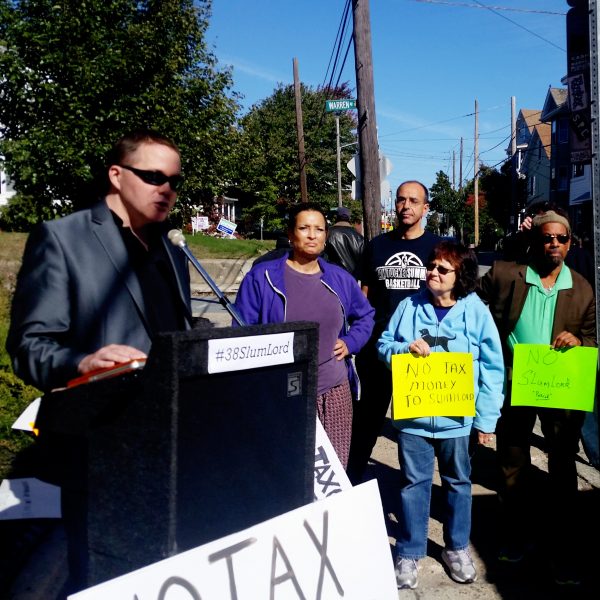 David Norton one of the leaders of the coalition that fought to keep the PawSox in Pawtucket and recently lost a Democratic primary election to unseat Pawtucket Representative David Coughlin, lead a protest outside Hope Artiste Village against Lance Robbins, controversial founder of Urban Smart Growth. As the ProJo reported, “Last month, the [R.I. Commerce Corporation] board authorized $3.6 million in Rebuild RI tax credits and $800,000 in sales-tax exemptions on construction material for developer Urban Smart Growth’s $38.9-million residential project at 200 Esten Ave., Pawtucket, just south of Hope Artiste Village.”
David Norton one of the leaders of the coalition that fought to keep the PawSox in Pawtucket and recently lost a Democratic primary election to unseat Pawtucket Representative David Coughlin, lead a protest outside Hope Artiste Village against Lance Robbins, controversial founder of Urban Smart Growth. As the ProJo reported, “Last month, the [R.I. Commerce Corporation] board authorized $3.6 million in Rebuild RI tax credits and $800,000 in sales-tax exemptions on construction material for developer Urban Smart Growth’s $38.9-million residential project at 200 Esten Ave., Pawtucket, just south of Hope Artiste Village.”
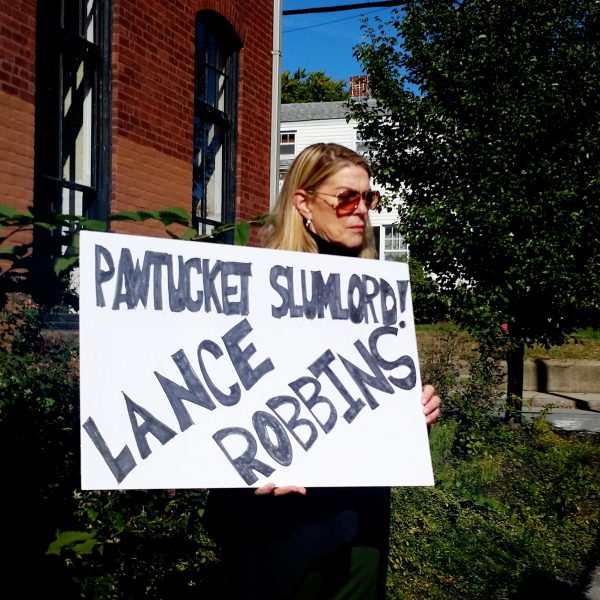 The downside, as reported extensively in GoLocal.com, is that Robbins has a reputation as “the worst slumlord in L.A. history, ” and his local reputation, with some business owners, is no better. Three of those business owners, Rosinha Benros, Phyllis Arffa and John Arcaro, spoke at the protest, and their stories are troubling. Each claim that their businesses were destroyed by the actions of their landlord, Lance Robbins.
The downside, as reported extensively in GoLocal.com, is that Robbins has a reputation as “the worst slumlord in L.A. history, ” and his local reputation, with some business owners, is no better. Three of those business owners, Rosinha Benros, Phyllis Arffa and John Arcaro, spoke at the protest, and their stories are troubling. Each claim that their businesses were destroyed by the actions of their landlord, Lance Robbins.
Also speaking at the protest were Independent candidate for Mayor of Pawtucket John Arcaro and Independent candidate for State Rep Lori Barden.
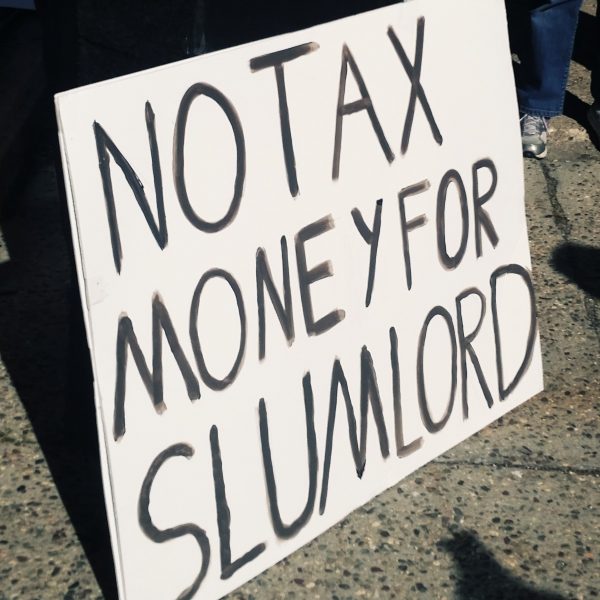
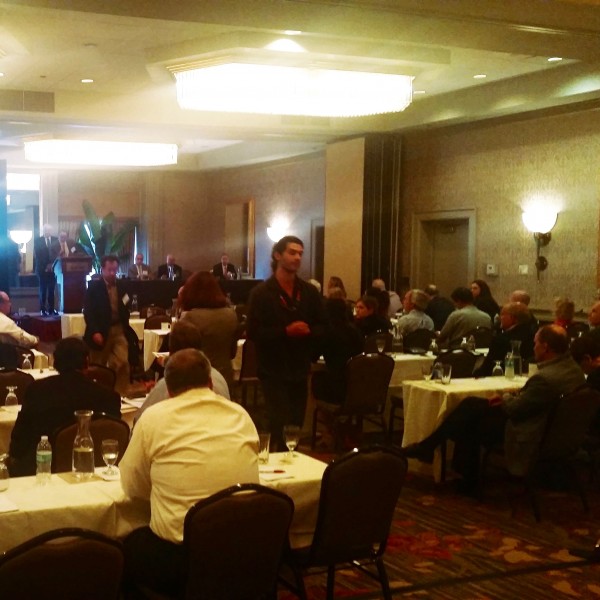 The Consumer Liaison Group (CLG) Meeting happens four times a year and its a chance for ISO-NE to exchange information with electricity consumers in New England. ISO-NE is the group that regulates our electricity markets and keeps the lights on by coordinating electricity generation and transmission. They run billion dollar markets and interact with companies like Spectra Energy, Invenergy, National Grid and Deepwater Wind. Pretty much every aspect of the process of getting electricity to your television is touched upon by ISO-NE in some way.
The Consumer Liaison Group (CLG) Meeting happens four times a year and its a chance for ISO-NE to exchange information with electricity consumers in New England. ISO-NE is the group that regulates our electricity markets and keeps the lights on by coordinating electricity generation and transmission. They run billion dollar markets and interact with companies like Spectra Energy, Invenergy, National Grid and Deepwater Wind. Pretty much every aspect of the process of getting electricity to your television is touched upon by ISO-NE in some way.
 The latest meeting of the CLG, in Providence on Thursday, featured a panel discussion with representatives from the four companies mentioned above. The panel was pulled together with the help of Douglas Gablinske, executive director of The Energy Council of Rhode Island (TEC-RI) an advocacy group for energy company concerns. Readers of RI Future may remember that Gablinske was a vocal opponent of Cale Keable’s bill to reform the Energy Facilities Siting Board (EFSB). He was also the only speaker at the RI Public Utilities Commission (RIPUC) to speak in favor of the pipeline tariff.
The latest meeting of the CLG, in Providence on Thursday, featured a panel discussion with representatives from the four companies mentioned above. The panel was pulled together with the help of Douglas Gablinske, executive director of The Energy Council of Rhode Island (TEC-RI) an advocacy group for energy company concerns. Readers of RI Future may remember that Gablinske was a vocal opponent of Cale Keable’s bill to reform the Energy Facilities Siting Board (EFSB). He was also the only speaker at the RI Public Utilities Commission (RIPUC) to speak in favor of the pipeline tariff.
Gablinske surprised me by asking if I knew about any planned protests or disruptions. I said I didn’t. He asked me specifically about the FANG Collective. I had no idea of what plans they have, if any, I said. Then Gablinske said that he noticed Mary Pendergast on the list of people who had signed up to attend. Pendergast was sitting in the room, and he soon went over to introduce himself to her.
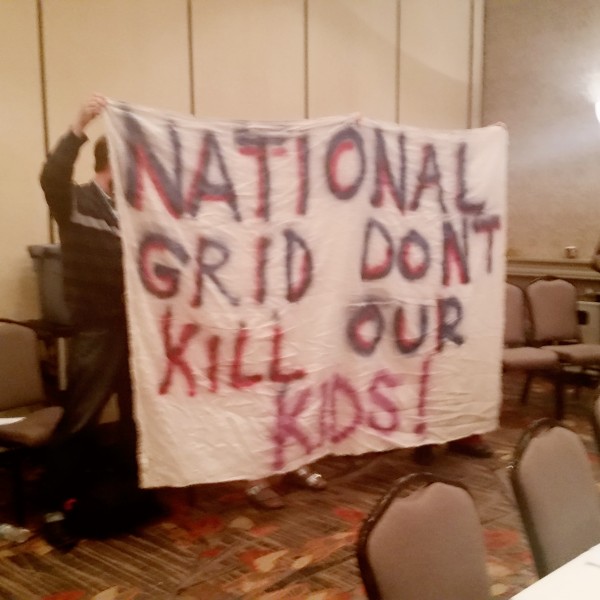
During the course of the presentation there was a disruption. As Invenergy’s John Niland gave his presentation to the room, Mary Pendergast stood and display a small sign that said, “No fracked gas Power plant.” Her protest was silent but it did seem to throw Niland off a bit, as his delivery seemed somewhat distracted.
It was during the third presentation that the disruptions became more pronounced. As Richard Kruse, vice president at Spectra Energy spoke glowingly about the need for bigger and better pipelines in our fracked gas infrastructure future, Kathy Martley of BASE (Burrillville Against Spectra Expansion), Keith Clougherty of the FANG Collective and Sally Mendzela stood up.
“Spectra Energy, Energy for Death,” said Martley as I headed for my camera. “Say no to Invenergy and tell Invenergy to go home,” Martley continued.
As the protest continued, Gablinske took the podium and said, “You have a right to be here but not be disruptive” as Clougherty continued to speak.
Lennette Boiselle, an ally of Geblinske and a lobbyist for the Northern Rhode Island Chamber of Commerce got up and left the room, presumably in search of security. Readers might remember Boiselle as the person arguing against democracy at the public comment hearing concerning Cale Keable’s EFSB bill.
“The political correctness, of not allowing other people to talk is sweeping through this country,” said Geblinske, “It’s an incorrect assumption, this gentlemen has the right to speak…”
“We’ve been listening to you our whole lives, Pal,” interrupted Sally Mendzela.
Gablinske ultimately offered to set up a forum where “both sides” could be heard but it is unknown if this will actually happen. The protesters took their seats, no one was ejected from the forum, and Kruse finished his talk.
Amazingly, though, that wasn’t the end. During a brief question and answer period at the end of the presentations, Gablinske called on Clougherty to ask a question!
“I would ask for a question, not a speech or a statement,” said Gablinske, when he realized who he had called upon.
Clougherty then asked Niland, Kruse and Bill Malee, a National Grid VP, “Do your companies have any money set aside for restitution for the millions of people who are going to be displaced and killed by the infrastructure projects you all are proposing?”
There is no good answer representatives from these companies can give, yet Niland attempted one. As expected, it was not good.
I found the most interesting talk of the day came from Mary Louise “Weezie” Nuara, External Affairs Representative for ISO-NE.
“The region’s competitive wholesale electricity markets are really designed to maintain reliability through the selection of the most economically efficient set of resources,” said Nuara, but the states “have environmental and renewable energy goals that are beyond the objectives of the wholesale electricity markets.”
What’s happening is that states are setting goals to increase renewables and reduce greenhouse gas emissions (like the goals set out in ResilientRI, but all the New England states have some version of this idea.) ISO-NE is designed to deliver energy as reliably and cheaply as possible. As a market, it cannot deliver renewables or reduce emissions unless those options are cheaper and cleaner. In August, NEPOOL (which represents the interest of the New England states when dealing with ISO-NE) began looking into how to adjust wholesale electricity markets to accommodate the goals of the states. It is NEPOOL’s goal to develop a “framework document” by December 2 to provide guidance to ISO-NE regarding potential changes. (A kind of advisory opinion, if you will.)
What makes this interesting, to my mind, is that if ISO-NE starts taking the climate change concerns of the states into account, plants like the one Invenergy is planning for Burrillville will have a harder time selling their energy into the markets.
ISO-NE is a little over a decade old, but already it’s finding that its systems are in need of being updated over concerns of climate change. By contrast, the EFSB here in Rhode Island was established thirty years ago, in 1986. The RI General Assembly has shown little inclination towards revising the EFSB’s mandate in lieu of climate change.
Below please find all the video from the CLg meeting except for the closing comments.
Rebecca Tepper, chair of the CLG Coordinating Committee and chief of the Energy & Telecommunications Division of the Massachusetts Attorney General’s office introduced keynote speaker Rhode Island General Treasurer Seth Magaziner.
Douglas Gablinske, executive director, The Energy Council of Rhode Island
Jeffrey Grybowski, chief executive officer, Deepwater Wind
John Niland, director of business development, Invenergy
Richard Kruse, vice president and regulatory & FERC compliance officer for Spectra Energy
Bill Malee, vice president of regulatory affairs, for National Grid
ISO-NE Q&A
]]> Governor Gina Raimondo and Providence Mayor Jorge Elorza disagree on whether emergency repairs needed for bridges across the 6/10 connector means the grassroots idea of turning the highway connector into a boulevard is now off the table.
Governor Gina Raimondo and Providence Mayor Jorge Elorza disagree on whether emergency repairs needed for bridges across the 6/10 connector means the grassroots idea of turning the highway connector into a boulevard is now off the table.
At a news conference today, Raimondo said the boulevard idea is dead because emergency repairs to seven of nine bridges over the 6/10 connector need to be fast-tracked. But Providence Mayor Jorge Elorza disagrees, according to his new communications director Emily Crowell.
“Not at all,” Crowell said when asked if the mayor agrees with the governor that the boulevard idea is unfeasible because of the emergency repairs the announced today. “We’re not abandoning the idea to make the 6/10 connector multi-modal.”
Raimondo and Department of Transportation Executive Director Peter Alviti announced that the 6/10 connector needs emergency repairs. Those emergency repairs, they both said, effectively take off the table the grassroots idea to turn the 6/10 connector into a boulevard instead of repairing it. The repairs to the Huntington Avenue bridge need to be finalized in 60 days.
Elorza spoke at the State House event today.
“We can invest these dollars in a way that ensures the public safety of this roadway and also enhances the livability of this entire corridor,” he said. “It’s our responsibility to advocate for the smartest investment of these dollars to move the city and the state forward and that is what we will be doing at the table alongside RIDOT and the governor’s office to advance this project.”
Raimondo and Alviti were unequivocal that the emergency repairs means the boulevard idea is off the table.
“We have to move immediately, so some options are closed” said Raimondo, when asked about the boulevard idea. “The time is out for debate. It’s time for action. I would love to be able to take a longer process but I don’t have that option.”
Alviti said, “Hypothetical plans or other scenarios could be explored in the world of theory but in the world of reality we are facing we now need to address this structurally deficient problem.”
Raimondo added that just because the boulevard idea can’t be done doesn’t mean some smart growth measures are off the table for the highway that cuts through the west side of Providence. “We’re going to take the next couple months to listen and if there are opportunities to put in a bike lane, we will listen.”
Raimondo and Alviti said that seven of the nine bridges over the 6/10 connector are “structurally deficient.” Because the problem is more severe than initially thought, these repairs are being fast-tracked.
“Not only is the bridge defunct,” said Alviti, “but the plan to fix the bridge is defunct.” He said the 6/10 connector bridge repair have been in the works for 30 years, but they have also been without funding for 30 years.
Simultaneously, a grassroots effort to replace the 6/10 highway connector with a boulevard was gaining momentum. James Kennedy, a regular RI Future contributor who has been covering the 6/10 boulevard idea, took to Twitter to criticize the announcement.
]]>The assembled crowd of 200 people at Tuesday night’s 6/10 Connector community meeting were unequivocal: no highway should be rebuilt along the corridor. It found a receptive if demur audience in Providence Planning Department and Mayor Jorge Elorza. RIDOT and Governor Gina Raimondo’s Office appear to be the only agencies backing the highway rebuild after the loss of a federal grant for the billion dollar project.
https://twitter.com/TransportPVD/status/770769768815132672
RI Future has been among several area publications that have called on Mayor Elorza to take a more direct stance on the project. While the mayor’s office has clearly favored a boulevard approach to 6/10, it hasn’t yet sought direct conflict with RIDOT or Governor Raimondo’s office. Following the rejection of a federal grant RIDOT intended to use towards part of the 6/10 corridor, statements from the agency have focused on the dire need to complete the highway rebuild with a minimum of public input. Read past coverage Tear It Down: Pictures of Our Potential 6/10 Future The Drivers’ Argument for the Boulevard On Tuesday night, Mayor Elorza did not seek direct conflict with the agency, but did refer to the 6/10 Connector as “really a Disconnector”, a sign of his preferences. In a Projo report leading up to the Providence meeting, RIDOT spokesperson Charles St. Martin bristled in his emailed response to questions on the project:
As we stated before, we cannot continue to postpone this work,” wrote DOT spokesman Charles St. Martin in an email. “Thanks to the passage of Rhodeworks, Rhode Island has $400 million in committed state and federal funding to draw from to address the Route 6-10 interchange. RIDOT is evaluating its options to tackle this problem and will soon present a recommendation for next steps. No decisions have been made at this time.”
This brings us to an important question: When is Gov. Raimondo’s office going to see the writing on the wall and redirect the agencies under her charge to better priorities? The assembled crowd was almost unanimous in its priorities. The process sat small groups at tables to outline ideas and present them. Each group, to the one, came up with some form or other of the following priorities:
- New housing
- Non-displacement of current residents while bringing in new residents
- Better outreach & a more welcoming process for Latino residents
- A full and complete bike and pedestrian network
- More green space
- Rapid transit to connect Providence within and without its city borders
- No highway
The groups varied in how they phrased these goals, but each group essentially outlined the same things. Notable about the meeting was the presence of individuals from communities like Cranston, Pawtucket, and Central Falls, whose citizens might have been more inclined to favor a highway than those having one built next to them. But those from outside Providence also favored the boulevard option. Among the attendees was Cranston at-large city council candidate Kate Aubin, who has made removing the 6/10 Connector a central tenet of her candidacy.
https://twitter.com/TransportPVD/status/770764144735838208
While Aubin is running on a progressive ticket, conservative Rhode Islanders also attended, questioning the priority of rebuilding 6/10 as-is. Rhode Island Center for Freedom & Prosperity’s Lawrence Gilheeney tweeted:
also, here's some pictures of last nights forum pic.twitter.com/mx3FGwvePa
— Larry Gillheeney (@LGillheeney) August 31, 2016
More pointedly, Brian Bishop, of the taxpayers’ rights group OSTPA spoke to the unnecessary waste of rebuilding the highway, drawing the night’s first laughter and applause:
https://twitter.com/TransportPVD/status/770775028090613760
Bishop, who owns properties on the East Side as well as a farm in Coventry, said that he was a “car person” and that others “can handle the bikes,” a friendly jab at non-OSTPA member Hugo Bruggeman, who held the table’s priority list and spoke to bike infrastructure like his home in the Netherlands. Bishop described the highway “hybrid” that RIDOT has been pushing over the Providence Planning-preferred boulevard as “brought to you by the same people who want to rebuild it again.” The audience roared with laughter at RIDOT’s expense.
With federal grants figured into the mix, RIDOT’s hybrid-highway proposal would have cost upwards of 80% of toll funds. Without that funding, it’s quite possible that rebuilding the highway as-is could put all other state projects on the back burner. Conservatives like Bishop and liberals like Aubin equally question the validity of this priority, despite living outside the city.
Which brings us back to a pointed question: Who exactly does favor the 6/10 Connector as a highway, other than RIDOT and Gov. Raimondo’s office? As a more politically diverse coalition coalesces around opposition to the plan, Gov. Raimondo is going to have to make some decisions soon.
~~~~
Correction: A previous version of this article erroneously named Lawrence Gilheeney’s group the Rhode Island Center for Freedom & Progress. It is the Rhode Island Center for Freedom & Prosperity. No doubt a liberal Freudian slip on my part. . . :-) Corrected.
]]> As part of the process, RIDOH issued an advisory opinion. Even a cursory reading of the document reveals issues so serious that they should prevent the construction of CREC. Yet another Rhode Island administrative body that lacks enthusiasm for the project!
As part of the process, RIDOH issued an advisory opinion. Even a cursory reading of the document reveals issues so serious that they should prevent the construction of CREC. Yet another Rhode Island administrative body that lacks enthusiasm for the project!
RIDOH identifies serious negative health impacts of noise:
According to the WHO [World Health Organization], sleep disturbance, one of the most common complaints raised by noise-exposed populations, can have a major impact on health and quality of life. People can recognize and react to sounds, even when asleep. Those reactions, including wakening and changes in sleep stage, are associated with daytime after-effects, such as sleepiness, reduced cognitive and motor performance, and impairment of cardiovascular function.
The RIDOH opinion also quotes written testimony of Julia O’Rourke, who lives on Wallum Lake Road in Burrillville:
Specifically, in the past year, I have experienced excessive noise and vibrations coming from the Algonquin Compressor Station site which this project will be located next to. The noise and vibrations emanating from this site are extremely disruptive and negatively impacting our health and we are unable to sleep or enjoy the peace and quiet of our home. I am concerned that the noise levels and vibration are only going to increase during the construction and operational phase of this project.
Clearly, the neighborhood around the CREC site and Spectra Energy’s compressor station will become unlivable. RIDOH suggests, if the plant were to be built, that Spectra Energy and Invenergy install sound proofing and buy “properties subject to noise levels that cause serious annoyance and/or sleep disruption.”
RIDOH’s opinion mentions that questions have also been raised as to whether National Ambient Air Quality Standards (NAAQS) of the Environmental Protection Agency adequately protect public health. We, and probably others, indeed raised those questions—those and quite a few others—in this public comment. The federal standards fail to account for short-lived pollution spikes which are typical for the operation of compressor stations and power plants. Nitrous oxides are are highly problematic in this respect. In addition, there are lots of other problems with “data” Invenergy’s submitted to the Energy Facility Siting Board.
Sure, we could go ahead with the construction of the power plant and turn Burrillville into a major air pollution dump. Is that justified simply to create a couple of jobs and export electricity to the Northeast? Can we justify that simply because “no states have promulgated a short-term NO2 standard that is more stringent than the NAAQS and the process for adopting such standards is arduous?”
Interestingly, RIDOH is much more advanced in its understanding of the effect of the proposed power plant than the Rhode Island Office of Energy Resources. RIDOH states:
The burning of fossil fuels and the extraction of fossil fuels by “fracking” both contribute to climate change by emitting various greenhouse gases to the atmosphere, most notably carbon dioxide and methane. Both have the effect of harming the health of Rhode Islanders now and in the future.
Of course, most of the methane problem occurs long before the fracked gas reaches Rhode Island. Information in a recent presentation of Rhode Island’s Office of Energy Resources shows that the office explicitly ignores such effects.
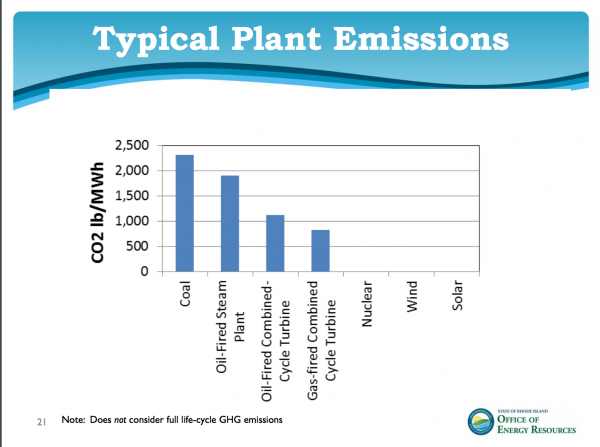
Not only does the office ignore basic science, it is also out of sync with federal guidelines on how the effects of greenhouse gas emissions on climate change should be taken into account. Those guidelines, issued last week, explicitly call for:
- Taking into account reasonably foreseeable direct, indirect, and cumulative GHG emissions and climate effects;
- Consideration of reasonable alternatives and the short- and long-term effects and benefits in the analysis of alternatives and mitigation
Unless we change course, Rhode Island will be doing neither. RIDOH writes:
We cannot measure the direct contribution of the proposed plant, or of any single facility, to public health by means of climate change.
Sure, but if we forge ahead without understanding what we do, we are in violation of the precautionary principle of the Rio Declaration, an international treaty signed and ratified by the U.S. This is the supreme law of the land:
Principle 15
In order to protect the environment, the precautionary approach shall be widely applied by States according to their capabilities. Where there are threats of serious or irreversible damage, lack of full scientific certainty shall not be used as a reason for postponing cost-effective measures to prevent environmental degradation.
How about we cannot “measure the direct contribution” of the plant to global warming? True enough, but we can easily estimate the impact of the national policy of which construction of the plant is part. Because natural gas is worse for the climate than oil and coal, the conclusion is simple: given the rate at which natural gas escapes unburned, and before the use of methane starts paying off, we’ll be dead, leaving an uninhabitable planet for future generations.
]]>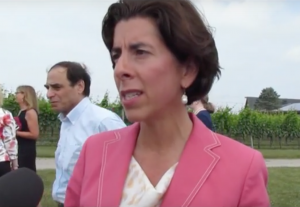 Future water shortages caused by CREC have been a topic of discussion and speculation for many months. That indeed there is a serious risk is clear from information contained in documents obtained from several Rhode Island departments in response to Fossil Free RI‘s request made under the Access to Public Records Act.
Future water shortages caused by CREC have been a topic of discussion and speculation for many months. That indeed there is a serious risk is clear from information contained in documents obtained from several Rhode Island departments in response to Fossil Free RI‘s request made under the Access to Public Records Act.
As a reminder, the following is worth quoting from a previous post based on documents supplied by the RI Department of Health:
According to a presentation at a meeting about CREC attended by several state agencies, 0.18 MGD (million of gallons of water per day) will be left for growth if the power plant is built. June Swallow of the Center for Drinking Water Quality at the Rhode Island Department of Health attended the meeting. Her longhand notes show that Harrisville and Pascoag each are expected to need 0.12 MGD for growth. This suggests a deficit of 0.24 MGD – 0.18 MGD = 0.06 MGD.
Also documents supplied by the RI Department of Environmental Management raise concern. There is, for example, the following email exchange between Alisa Richardson of RIDEM and Ken Burke formerly of the Rhode Island Water Resources Board:
Thanks Alisa,
I think we should talk about having the Town acknowledge that with low flow conditions and high energy demands, that the Town is effectively pledging most (if not all) of its available water to this development. This local decision is theirs to make. Will someone from the Town also be at this meeting?
Thank you,
Kenneth J. Burke, P.E.MBA
General Manager/Treasurer
This email (my emphasis) appears on page 50 of this document. There is more of interest, but the conclusion is the same; search the document for “Alisa” and “Ken.”
Also Stephanie Sloman, a retired environmental engineer who worked for a large electroplating plant in Massachusetts, weighed in. She submitted a thorough and detailed testimony to the Invenergy docket of the Energy Facility Siting Board.
Her conclusion is that, no matter how you look at it, there is not enough water for future growth in Burrillville and the other towns that draw from the same source.
Clearly, the RI departments of Environmental Management and Health, and the Water Resources Board are aware of the looming water supply problem. As Stephanie Sloman explains, anyone capable of elementary arithmetic can check this. As she points out, Invenergy is apparently is not one of those.
Recently, Gina Raimondo mentioned that she would withdraw her support for the CREC project if there were any issues. Of course, trouble with the water supply is only one of a myriad of issues each single one of which should suffice for her to make good on that promise.
]]>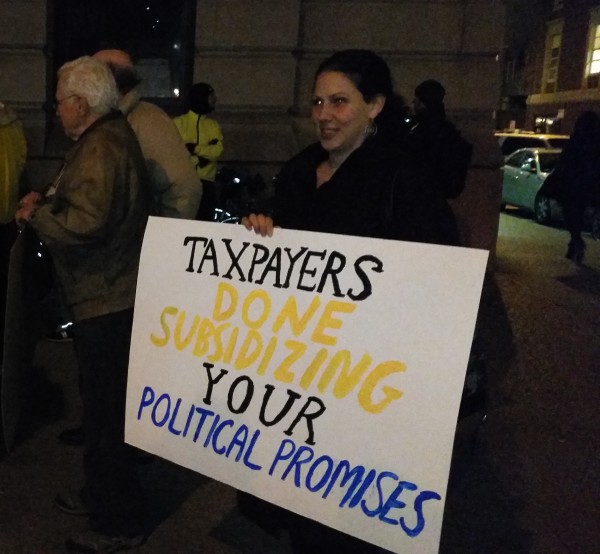
RI Future’s recent coverage of a tax stabilization agreement (or TSA) for Rising Sun Mills admirably pursues the idea of a fair tax system for all Providence residents. There’s a lot I agree with about this approach. At its roots, TSAs are an insider deal. But the logic behind TSAs makes a lot more sense than is obvious at a first glance. The goal for the city should be to establish a tax system that mirrors some of the features of TSAs, rather than carve out special agreements for the well-connected.
What is a TSA?
To begin with, what is a TSA? Tax stabilization can take many forms, but they’re usually agreements that require the owner of a property to pay the same taxes that were previously paid, though not more, in return for the property owner adding a new building or refurbishing an endangered one. (thus, a tax “stabilization”).
On the face of things, that arrangement sounds really unfair, but it makes more sense if you look at the costs that a building owner is supposed to cover with their taxes and think about how those costs change (or stay the same) after the refurbishment. An infill or renovation project in a city does not require a new sewer extension, but can be hooked up to existing lines. It does not require new streets. If it receives transit service, it’s usually on an existing line, and the new building will add ridership rather than adding miles of service area. A building being occupied may actually help to lower crime without more policing, and in any case it will be built within an existing police precinct. A building covered by an urban TSA will often be a solid building, perhaps even a historic renovation, that is intended to last a long time.
Contrast that to the typical suburban sprawl* project, like a Walmart. It will require acres of new land, and to function will need a sewer extension, gigantic new roads, or road and interchange expansions. It will add greatly to the surface runoff costs of the sewer system as well, with gigantic parking lots. Big box projects like Walmarts often demand transit service for their low-wage workers, but design everything about their facilities in order to defeat the efficiency of that service– after all, the customers and managers drive– delivering a transit service that costs a lot and delivers very little. Sometimes a single project will be the size of a small urban neighborhood, adding tremendous strain to traffic, and requiring a new police or fire precinct. For all the investment that is put into such a deal, the buildings the big box brings are meant to have a thirty year life cycle at most, and often the big box company will require land covenants that disallow competitors to move in if they should happen to leave the building (they often do leave the building, repeating this process).
Suburban projects look like a good deal because politicians won’t pay for all the additional costs that these projects bring. Those costs will accrue decades from now.
Urban and suburban communities both compete with each other to give away tax deals, and to be fair, urban TSAs are an insider deal just like any other. The politicians that prepare these deals don’t necessarily think about all the economic logic I presented above. The way they see it, the deal is about jobs for their ward. They care very little about the long-term effects. Urban TSAs happen to be a much better deal, but that’s not by design.
Fixing the TSA
Instead of creating TSAs for individual projects, we should make our tax system look a bit more like what a TSA tries to accomplish, but for everyone. A land tax should be a component of our tax system, used to offset a lower property tax. This isn’t exactly the same as a TSA. Under this arrangement, creating improvements to a property– adding buildings, fixing a roof– would still raise the value of the property and kick in more tax revenue from the property tax part of the tax model. But the land tax would stay the same– tied to the amount of land used and the resources consumed by that parcel.
Equity is a big concern under TSAs, not only for the fact that some can get a TSA and some can’t, but also because of the particular services that suffer in a city when not enough tax revenue is present. I would propose that the services paid for by the land and property tax sections of the tax code by bifurcated carefully. The land tax should pay for the things that resemble “pay for what you use” items– roads, sewers, transit, etc. The property tax should pay for things that we conceive of as “each according to their ability” services– libraries, schools, and other social services. By separating the budgets in this way, we ensure that when we tax a more valuable property, we’re tying that taxation to our ideal of sharing, rather than creating a slush fund to allow for wasteful infrastructure extensions.
Land taxes already exist in many places– my home state of Pennsylvania is one. They’re not a magic cure-all, and in order to fix our cities, we’re also going to have to stop subsidizing sprawl. Part of why I react to the criticism of TSAs is that the overwhelming nature of our subsidy mix is to ever-expanding consumption of undeveloped land for new strip malls or big boxes, cul-de-sacs and highways. The Rising Sun Mills project lost a tenant to Johnston because all the advantages of being in the suburbs– parking, big roads, etc.– are pre-paid features of life in America– while all the advantages of living in the city– walkability, community, and so on– are privatized goods to be bought and sold. We have to break that pattern. A land tax could be one step towards that.
~~~~
*”Suburban” is an ambiguous term, but here I mean suburbs that are totally car-oriented, cul-de-sac driven, post-1950s-style suburbs, rather than suburbs that have the form basically of a small walkable town that extends out from a city. Think Warwick or Johnston, rather than Bristol or Warren.
]]>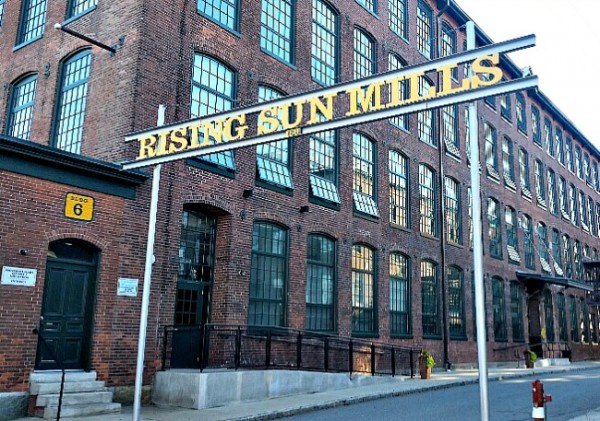 The Providence City Council extended a tax break for the developers of a mixed use project on Valley Street because an anchor tenant relocated to Johnston.
The Providence City Council extended a tax break for the developers of a mixed use project on Valley Street because an anchor tenant relocated to Johnston.
“Do we really need another vacant or foreclosed property in our city,” said Council President Luis Aponte, who voted for the so-called tax stabilization agreement, after the meeting. He said the developers could have attained an administrative TSA for a smaller redevelopment had the council not awarded the tax break and that the city negotiated a good deal for residents by working with the developers.
Councilor Carmen Castillo was the only member of the elected board to vote against the TSA.
“We’re not a bank,” she said. “The neighborhood I represent never gets a tax break. We pay a lot in property taxes too.”
Councilor Sabina Matos said she supported the TSA because the council approved TSAs for downtown businesses so it was only fair that it do so for businesses in her district too. “We set a precedent,” she said. “We can’t give them to some developers and not others.”
Abacus Technology paid $1.8 million annually to rent 100,000 square feet of space in the Rising Sun Mills development on Valley Street but the company has decided to move to Johnston, said the developers.
“There’s no benefit to having Rising Sun Mills go dark,” said BJ Dupre, one of the developers, after the favorable decision from the Council. When asked if that would have happened if they didn’t get the tax break, another of the developers, Mark Van Noppen said it was a “distinct possibility.”
Aponte said the developers plan to reconfigure the commercial space into smaller offices. He said the TSA is void if they don’t pull all the requisite permits in 180 days.
“It’s hard to tell,” Aponte said when asked how much money the city budget would lose by extending the TSA to the Rising Sun Mills project. But, he added, “They are paying more than if they would have got a 5 year extension” as a result of the negotiations with city officials.
]]>